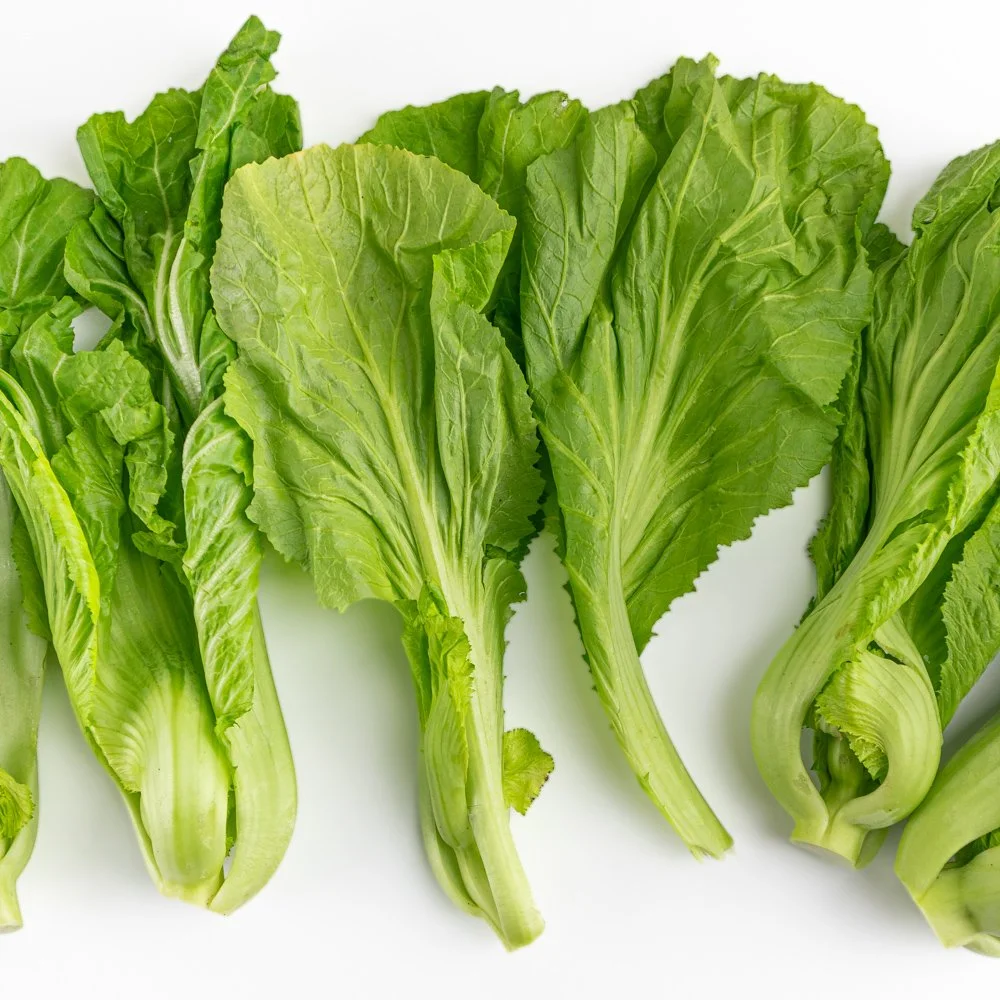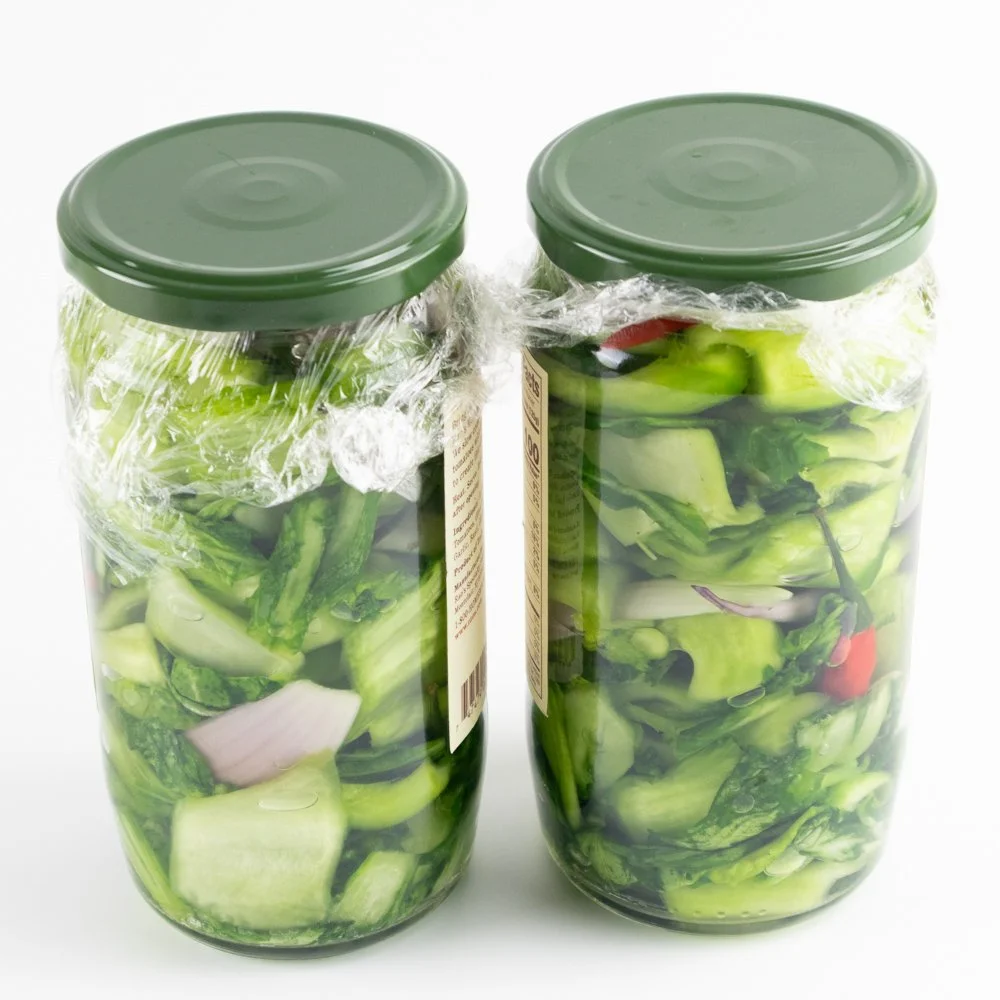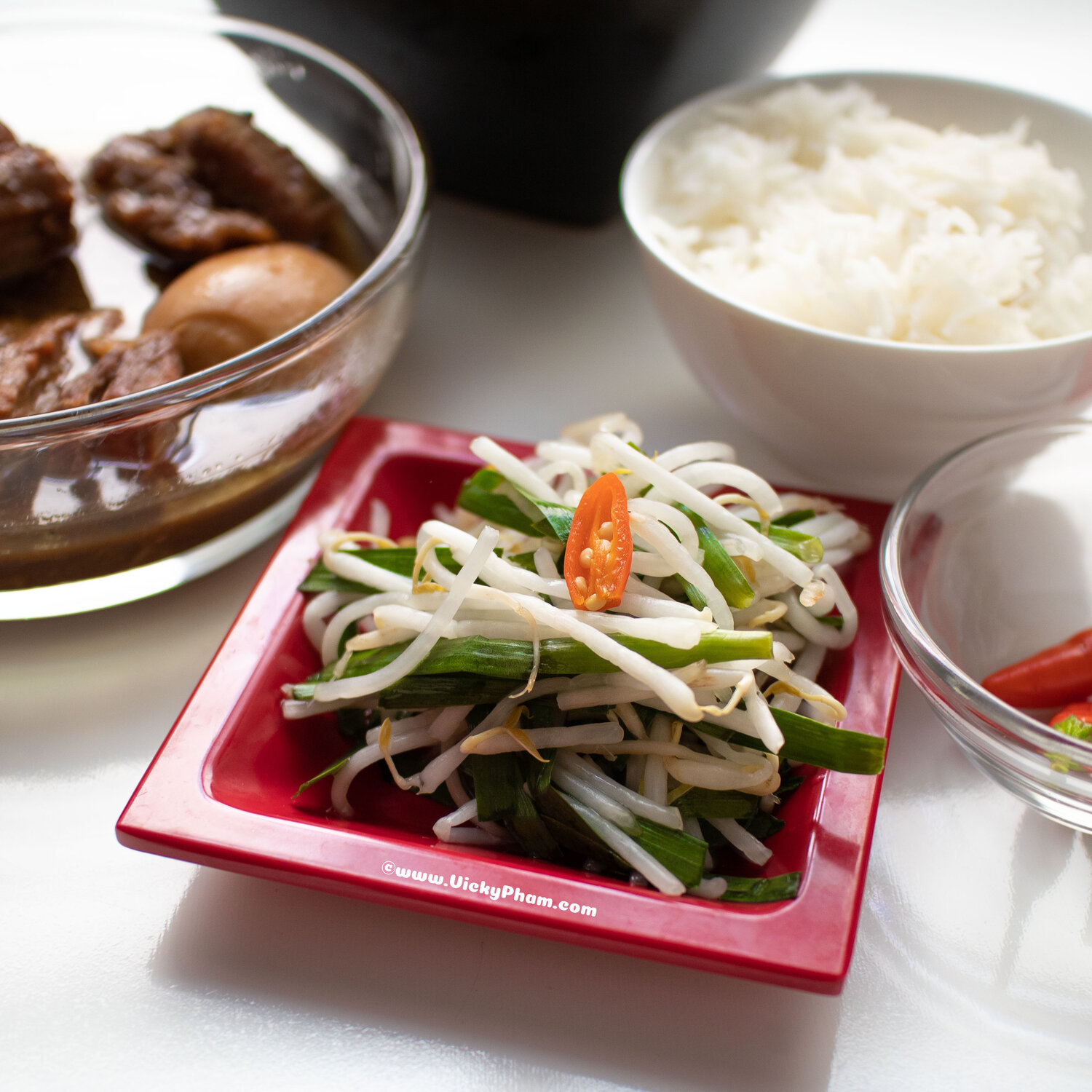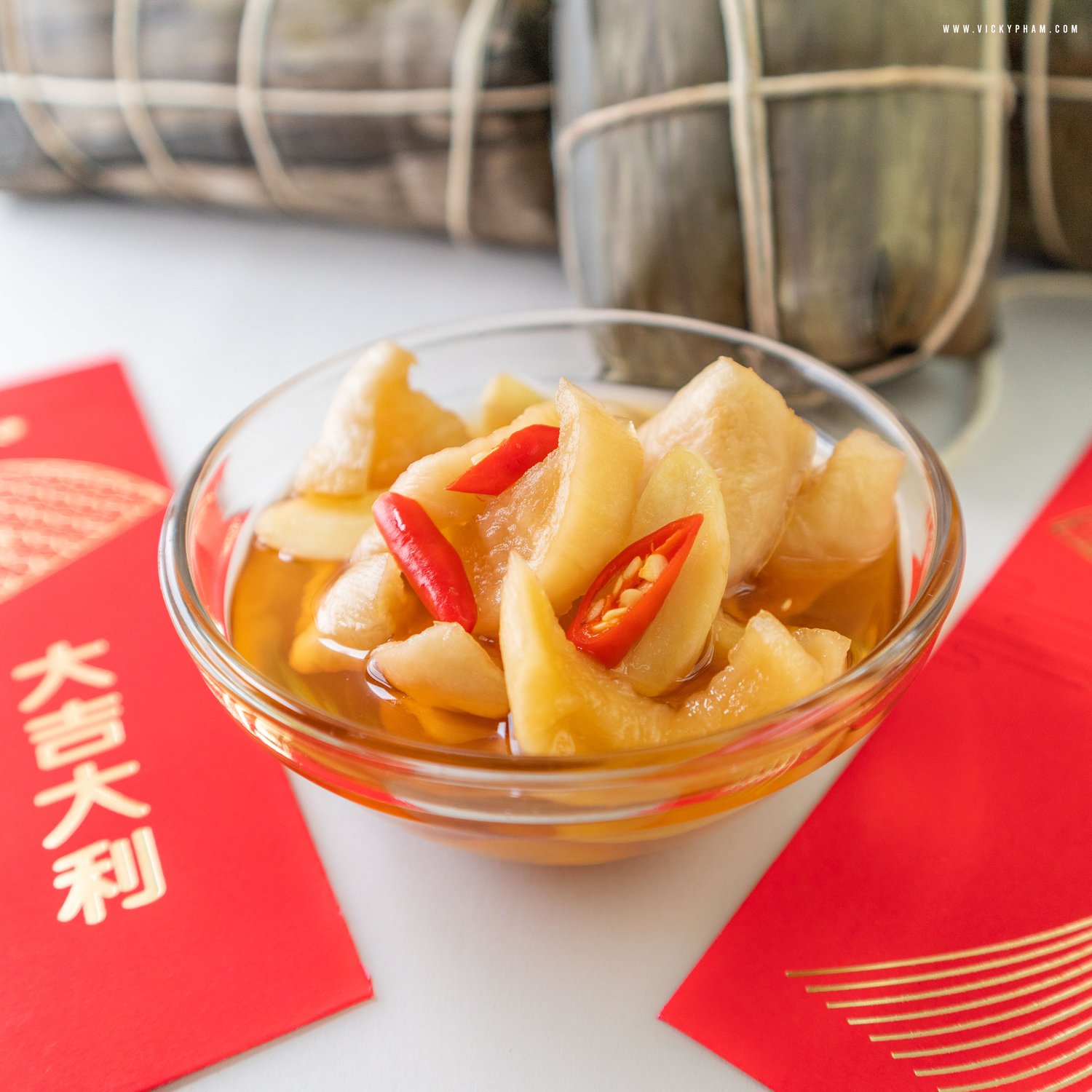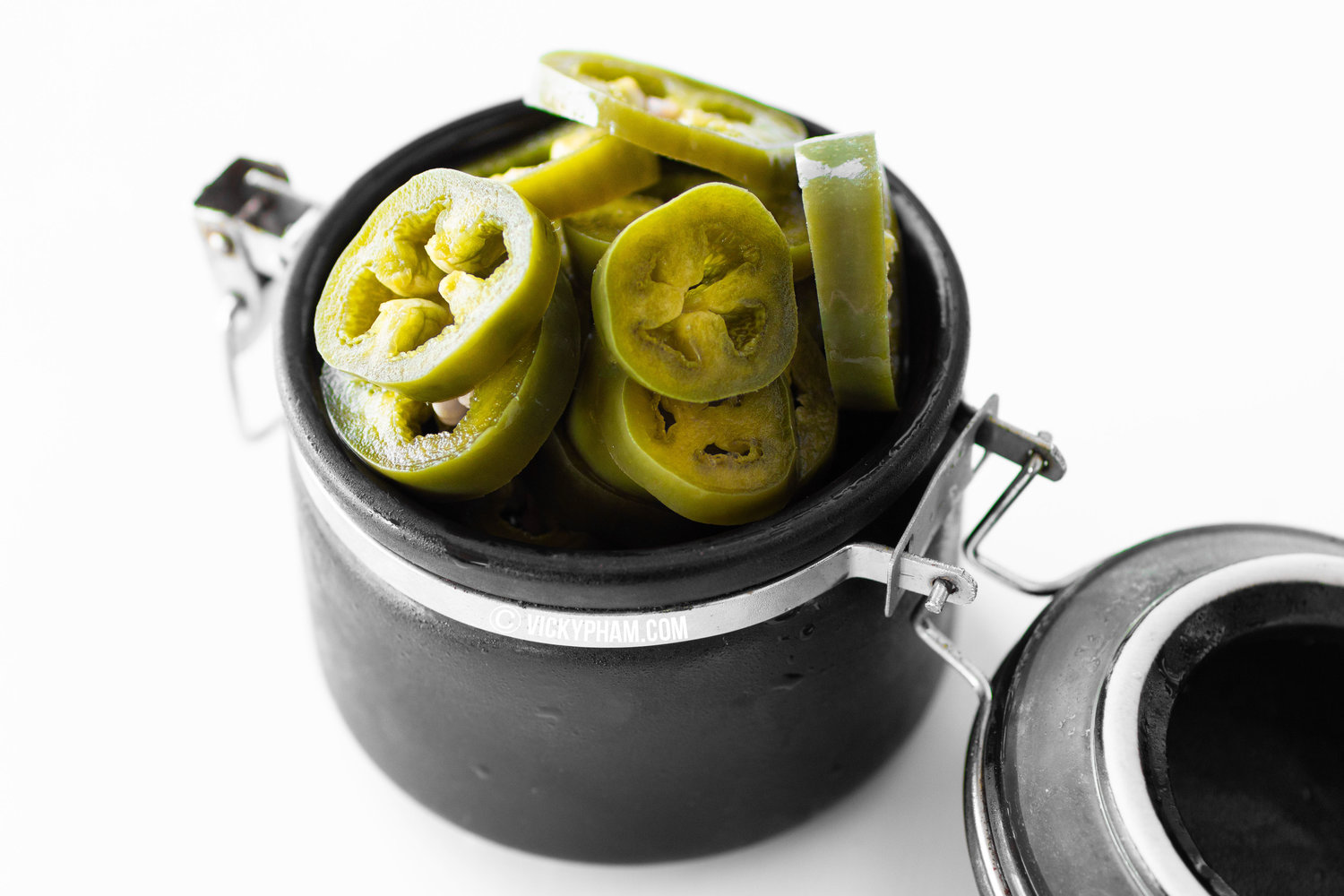Vietnamese Pickled Mustard Greens (Dưa Cải Chua)
This post contains affiliate links which we are compensated for if a purchase is made. Using links costs you nothing and helps to support the ongoing creation of content. • Jump to Recipe
What is Vietnamese Pickled Mustard Greens?
Vietnamese pickled mustard greens (Dưa Cải Chua or Dưa Muối) are an essential side dish for Thịt Kho Tàu, Vietnamese braised pork belly and eggs.
These two are enjoyed not only as traditional dishes throughout the year but staple foods during the Vietnamese Lunar New Year celebration (Tết).
In this recipe, we’ll make pickled mustard greens with salt fermentation for a natural sourness.
We are also skipping the traditional Vietnamese step of sun-drying the mustard greens.
You can expect crunchy and tangy pickled mustard greens in 3-4 days.
Vietnamese Pickled Mustard Greens (Dưa Cải Chua)
Salt Fermentation
Salt fermentation, or lacto-fermentation, is an age-old technique that naturally preserves vegetables. The only requirements are vegetables, water, salt, and time.
Unlike pickling with vinegar, salt fermentation allows the natural lacto-fermentation process to occur.
The salt brine kills off unwanted microorganisms and encourages the lactobacillus bacteria (present on the surface of all vegetables) to convert sugars into lactic acid. This creates a naturally sour taste and preserves the mustard greens without the need for any artificial preservatives or additives.
What You Will Need
Mustard greens: Known as Gai Choy in Chinese/Cantonese and Cải Xanh or Cải Bẹ Xanh in Vietnamese. You can find them in the produce section of Asian grocery stores.
Asian grocery stores carry a variety of mustard greens under different names. If it's not labeled as Gai Choy, the most common name, look for one that labeled leaf mustard, mustard cabbage, vegetable mustard, or Indian mustard.
For this pickling recipe, look for the mustard greens with wide and fanning light green stems with large dark green leaves. See picture below for reference.
The leaves and stems have a strong, bitter, and peppery flavor when raw, but mellow out when pickled. Both stems and leaves are pickled.
Fresh Chinese mustard green (Gai Choy)
Salt: Regular table salt is used.
Sugar: Granulated white cane sugar adds a touch of sweetness to balance the sour taste.
Water: We can’t have a brine without water.
Shallots and red chili peppers (optional): Shallots enhance the aroma, and whole chili peppers provide spiciness without leeching into the brine.
Containers: I’m repurposing two 28 oz Rao's marinara sauce jars.
Brine: water in a stockpot, sugar, red chili peppers, sliced shallots and salt.
How to Make it
Step 1: Prepare the Mustard Greens
Cut off the root end of the mustard greens and discard. Separate the leaves and wash well with water. Dirt tends to stick on the lower stems.
After washing the mustard greens, cut stems and leaves into 1-inch segments.
Step 2. Salting
Place the mustard greens in a large bowl, sprinkle with salt, and massage gently. The salt draws out fresh water, which will be replaced with brine water for a successful fermentation. It also reduce the volume of the mustard greens for easy packing. Allow it to sit for 30 minutes then rinse and drain dry, removing all of the salt.
Salting the mustard greens so they can wilt and release water.
Mustard greens after salting and rinsing.
Step 3: Make the Brine
In a medium stock pot, bring water to a boil. Turn off heat. Add sugar and salt. Mix well. Set aside to cool until warm.
Step 4: Packing
Make sure to clean and sterilize the jars with boiling water before using.
Evenly divide the mustard greens between the jars. Layer in the sliced shallots and whole chili peppers as you fill the jars. Press down firmly to remove any air pockets.
Pour in the brine until it completely submerges the vegetables. There will be extra brine just in case you spill some. You can save it to pickle other vegetables (garlic is a great choice for the small remaining amount) or discard.
Step 5: Fermentation and Storage
Cover the opening of the jars with saran wrap for a better seal then screw on the lid. The plastic also prevents rust if the underside of the lid contains metal.
Store at room temperature for about 3-4 days. The exact time will depend on your climate and how sour you prefer your greens. Taste them periodically to find the perfect balance.
It should turn a dull green/yellow color over time with the brine remaining clear.
Once the mustard greens have reached your desired sourness level, store them in the refrigerator to slow down the fermentation process. They can be kept for up to two months in the fridge.
Serving
These pickled greens are traditionally served alongside Thịt Kho Tàu, a Vietnamese caramelized and braised pork belly and egg dish. They add a tangy note that complements the fatty pork well.
Pro-Tips
Keep Vegetables Submerged: Ensure the vegetables are always covered in brine. Push them down, or use wooden skewers placed tightly across the top to keep the vegetables submerged.
Temperature: The ideal fermentation temperature ranges between 68°F and 72°F.
Cleanliness: Use sterilized containers and tools to prevent introducing harmful bacteria into the fermentation process.
FAQs
Can I use other types of salt?
Yes. Any salt will work. I’m using iodized table salt.
How do I know if the fermentation has gone wrong?
Bad fermentation is usually accompanied by unpleasant odors, mold, or a slimy texture. If you see any of these signs, it's best to discard the batch and start over.
Can I speed up the fermentation process?
Yes. The fermentation can be shorter if you live in a warmer climate or if you place the jar in a warmer area, such as on a windowsill with sunlight.
Other Tết Recipes
If you enjoy this recipe, you might enjoy these:
Bánh Chưng‘s Cylindrical cousin (Banh Tet)
Red Sticky Rice
Steamed Whole Chicken
Ground Pork Stuffed Bitter Melon Soup
Crispy Egg Rolls
Caramelized and Braised Pork Belly with Eggs
Spicy Beef Jerky (No Food Dehydrator Needed)

Vietnamese Pickled Mustard Greens (Dưa Cải Chua)
Ingredients
Instructions
- Cut off a thin slice of the root end of the mustard greens and discard. Separate the leaves and wash well with water. Dirt tends to stick on the lower stems. After washing the mustard greens, cut stems and leaves into 1-inch segments.
- Place the mustard greens in a large bowl, sprinkle with salt (1 tablespoon), and massage gently. Allow it to sit for 30 minutes.
- In the meantime, make the brine. In medium stock pot, bring water to a boil. Turn off heat then add sugar, and remaining salt (2 tablespoons). Mix well. Set aside to cool until warm.
- Rinse the greens well under cold water to remove all the salt and drain dry. Evenly divide them between two jars. Layer in the sliced shallots and whole chili peppers as you fill the jars. Pour in the warm brine until it completely submerges the vegetables. There will be extra brining liquid. Save it for another pickle recipe or simply discard. Cover the opening of the jar with saran wrap then screw on lid.
- Store at room temperature for about 3-4 days. Once the mustard greens have reached your desired sourness level, store them in the refrigerator. It should turn a dull green/yellow color over time with brine remaining clear. They can be kept for up to two months in the fridge. Enjoy with Thịt Kho Tàu, a braised pork belly and egg dish or any other protein dish.
Nutrition Facts
Calories
10Fat
0 gSat. Fat
0 gCarbs
2 gFiber
1 gNet carbs
2 gSugar
1 gProtein
1 gSodium
1079 mgCholesterol
0 mgThe values provided should be considered estimates. Factors such as brands purchased, natural variations in fresh ingredients, etc. will change the nutritional information in any recipe. To obtain accurate nutritional information for a recipe, use your preferred nutrition calculator to determine nutritional information with the actual ingredients and quantities used.


